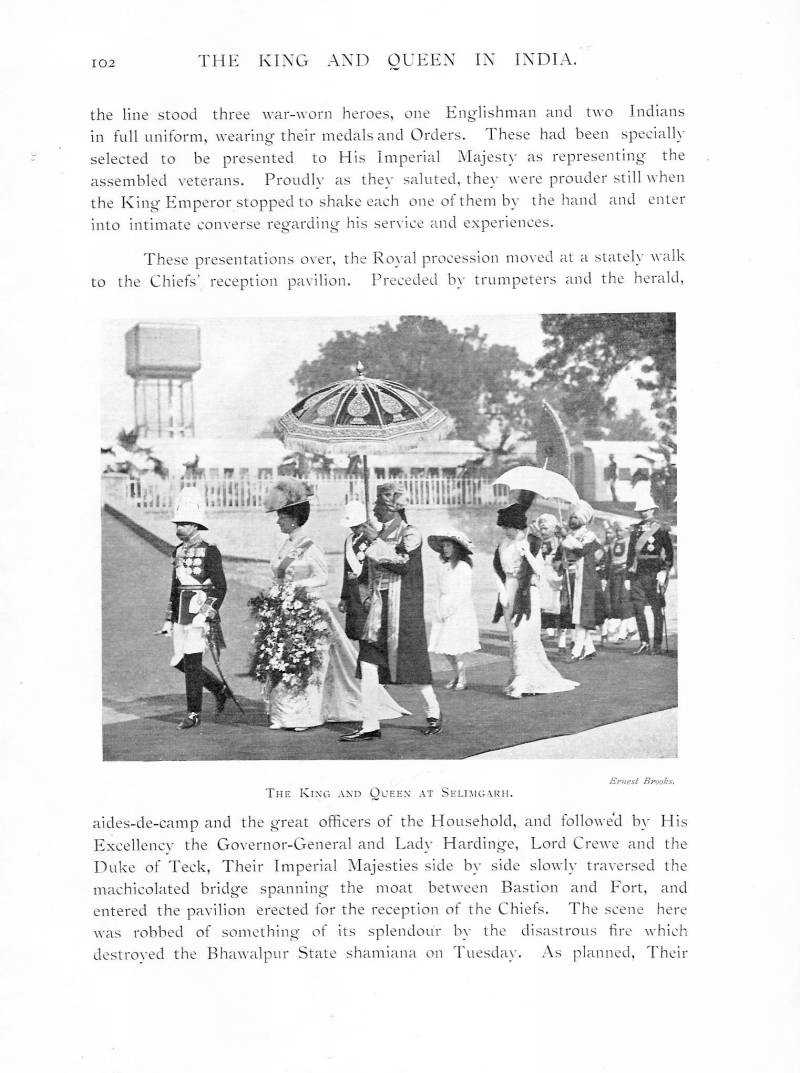The Royal walk from the carriage
on their arrival at Salimgarh Fort

N E X T
..Majesties were to have received the great feudatories in the most magnificent canvas hall in India, a hall upheld by silvern pillars and glowing with Bhawalpur applique work in reds and blues and yellows, whose hard colours blended marvellously in the chastened light of the pavilion. Alas! that marvel of the tent-maker's craft is now no more than a few charred rags. Whilst the pavilion hastily improvised could not vie with it in decorative effect, the ceremony had a quiet dignity of its own. Amid fresh salutes from Rajput Infantry and Tiwana Lancers, Their Imperial Majesties took their seats in chairs of State at the far end of the pavilion, surrounded by the Ruling Chiefs who have so large a stake in the prosperity and peace of the land, clad in the richest ceremonial dress resplendent with priceless jewels. These were individually presented-the Nizam of Hyderabad, called suddenly to the governance of the premier Native State through the death of his respected father, then the Gaekwar of Baroda, the Maharajah of Mysore, the Maharajah of Kashmir, and the other Chiefs in territorial groups.
Brief as the proceedings were, they were marked by state and dignity. Her Majesty had a smile for the little Nawab of Bhawalpur which must have robbed the ceremony of all terrors for him. Then, although definite intimation had been given that no nazars were to be offered, one Chief, the Rajah of Sikkim, was so overcome with his emotion and his conception of the Oriental fitness of things, that unwinding his gold-embroidered shawl he laid it at the feet of Their Majesties, striding manfully away with the consciousness of dutv well-done.
This ceremony over, the King Emperor mounted his horse, a matchless bay' of sixteen hands and more, and the Queen Empress took her place in a carriage of State, an open landau drawn by six bays with postillions and grooms in scarlet. Her Majesty was accompanied by the Mistress of the Robes, the Duchess of Devonshire, and the .Lord High Steward, the Earl of Durham. As the procession moved, the guns spoke again, this time from the Ridge, firing the Royal salute not by single guns, but by salvoes of Batteries that shook the air with their thunder. The scenes which greeted Their Imperial Majesties on their progress through the fort were singularly suggestive. They passed the British barracks, gaunt and repellent in their uglifless, yet in their unornamented solidity so reminiscent of some of the strongest elem'ents of British rule. They passed the broad central walk showing on the left hand the Naubat Khana and the Dewan-i-Am, where Shah Jehan sat on the Peacock Throne, and on the right the noble aisle of the Lahore Gate. Cheek by jowl with these monuments of a mighty....
Some time in the dim and distant past one of those individuals born to mislead his kind invented the phrase "The Changeless East". The English are the most phrase-ridden people in the world, and we have gone on talking about the changeless East and the grey conservatism of Asia, until those who know no better really believe the East is standing still. Was ever a more preposterous nonsense discussed? The changeless East? Look at what has happened in Japan, at what is happening in China today , and at what has actually occurred in India ! Stand on the summit of one of the minarets at Delhi Jama Masjid and see the clouds of smoke pouring from the chimneys of the industrial quarter, or ascend the Fort at Agra and note the noxious blackness sweeping ominously over the Taj; listen to the roar of the jute mills at Howrah or the spinning factories of Bombay, and then talk of the changeless East. More significant still, study the complexion of the Legislative Councils created to assist the Viceroy and the Provincial Governors, with their evidence of the growth of the influence of the Indian middle classes, and then perhaps you may begin to realise the truth, which is that rapidly as the world is moving to-day, the dynamic forces shaking the ageworn institutions are in no sense behind those stimulating the progress of the Occident.